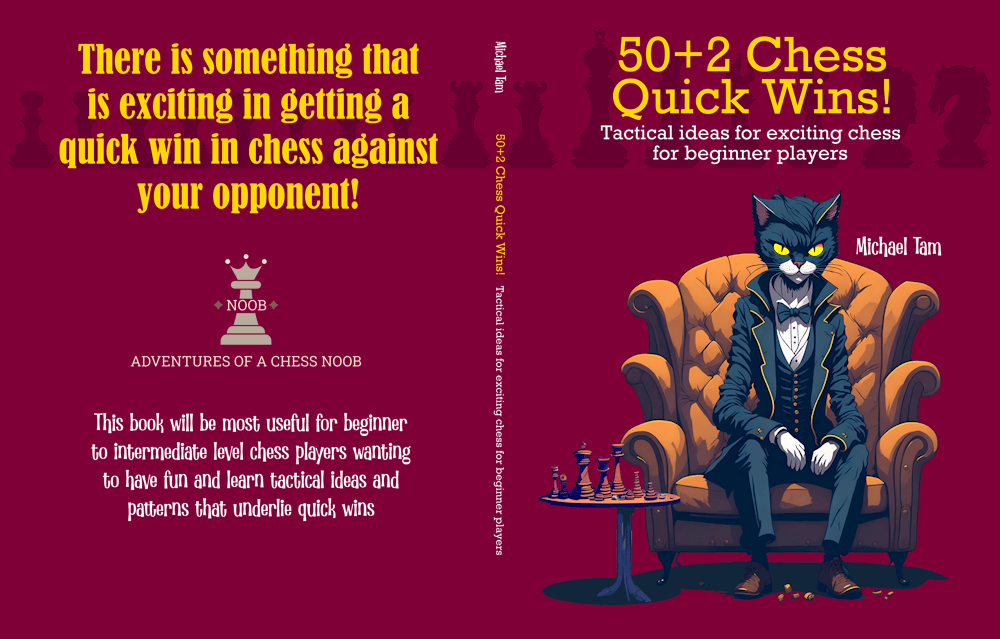
Vienna Gambit | Queen Blunder Comeback! 🤩
#viennagambit #queenblunder #reversal
A little while ago, I wrote an article and recorded a video about the reversal, transforming a losing position into a win through a planned tricky manoeuvre. As noted previously, I find it wone of the most exciting experiences in chess. From the perspective of framing – it also means that you’ve something to play for after making a dreadful blunder. In this game, I carelessly blunder my queen on move 10… 😭

![]()
As with many of my adventures in chess, it began with the Vienna Gambit, to which my opponent with the black pieces declined with d6 (1. e4 e5 2. Nc3 Nf6 3. f4 d6). Those of you who are Vienna Gambit aficionados will know that the best response to the Vienna Gambit (Falkbeer) is to enter the Vienna Game Main Line with (3… d5). However, if one chooses to decline the gambit, then (3… d6) is the next best option.
With White, our next tactical step in the opening is relatively simple. We want to play d4 to control the centre with pawns, but this will be best supported with a piece in addition to the queen. Otherwise, after a capture sequence of: d4 exd4 Qxd4, Black develops their queen’s knight with Nc6, and wins tempo on our queen. So, we first develop our king’s knight (4. Nf3) to prepare for d4 and play that the next turn if allowed.

![]()
Now, the capture sequence gives us the advantage, (5. d4 exd4 6. Nxd4 Nxd4 7. Qxd4), as we finish with my queen commanding the centre of the board!
In the position, it isn’t obvious for Black their best way to develop in the opening, and indeed, their next two ideas (7… Qe7?!) and (8… g6?!) are inaccuracies that move the evaluation to [+2]. For Black, the e7 square is not great for the queen in the Vienna Game opening as White is ever ready to leap forward with the queen’s knight to d5, with an attack on the queen and Black’s c7 square (which comes with an absolute fork of king and rook). As for g6, a fianchetto king’s bishop (9… Bg7) can be a tricky way to play for Black against the Vienna, but it risks weakening the dark squares around the king, especially if Black castles short.
In this position, on move 10, I make my OBVIOUS blunder! This was an unrated game of 10-minute rapid with no increment. This is what I sometimes play as a de facto game of low-stakes blitz when I don’t have much time, and don’t want to think too hard! 😅 My logic was that I wanted to pre-emptively move my queen off the long dark square diagonal after Black’s bishop parked itself on g7. With minimal thinking (I played the move in 5.1 seconds), I stepped my queen forward one square (10. Qd5??) thinking that I had a battery with the light square c4-bishop. Except that d5 was, of course, defended by Black’s f6-knight! This impulsive move resulted with a clean loss of my queen… 🤣
Now, I’ve played enough games of chess to know that some people will rage quit after losing their queen after such a blunder. That, however, isn’t my style. No one ever won by resigning! As noted in the opening, we can frame this a different way. We have the opportunity to play for a reversal! We play for at least a draw and optimally for a win! This can be immensely fun and rewarding!
Strategically, it’s important to recognise that the position is already losing. From that perspective, the accuracy of moves is of lesser importance as a loss is a loss. Rather, to get a reversal, one must create opportunities for our opponent to make mistakes and blunder. And to do that, we tactically want to play aggressively, making threats on the board, creating complications, and play moves which may be unexpected such as piece sacrifices! A material disadvantage in the opening stages of the game might not be felt, especially if the opponent is behind on development.
So, my immediate next move was (11. Nxd5) placing pressure on Black’s queen on e7. Now arguably, Bxd5 is better as Black has a follow up Qxe4. However, I wanted to set the aggressive tone and see how Black would respond… and they played (11… Qd7?!), yes!
A very common response when you opponent has an unexpected windfall like winning a queen is that the loss aversion bias kicks in! For many people, after winning a material advantage, they will instinctively hold onto that advantage, and prioritise that over taking further perceived risks. For Black, Qd7 is a defensive and conservative move that moves it out of the attack. Black wants to “protect their queen” rather than use it to press for the advantage in an attack immediately. This gives me an avenue for a counterattack! 🤩
The queen’s knight on the d5 square is a common and powerful tactic in the Vienna Game. With White’s queen now on d7, I noticed that Nf6 would be a royal fork! However, I needed to deflect Black’s fianchetto g7-bishop to make it work. So, (12. f5) to open the dark square diagonal for my own bishop, with a plan for Bh6!

![]()
Black captured the pawn as expected (12… gxf5) and so (13. Bh6!?). If Black captures the seemingly hanging bishop with Bxh6, then Nf6+ royal fork! Making threats, creating complications, piece sacrifices – inviting our opponent to blunder!
Black resists the temptation and castles. No problem! Notice that Nf6 remains a royal fork after Black’s castle! Notice further that after Black’s (12… gxf5) and (13… O-O), that Black’s king is now on a semi-opened g-file… meaning, that it could be attacked directly down the g-file! The way to exploit this is to add an extra attacker, so rook lift with (14. Rf3), as Rg3 would be extremely powerful! 😀
The curious thing here is that according to the engine, Black is completely winning at better than [-5] and up 7 points of material. Under the cold-blooded calculation of the engine, Black’s most accurate move is in fact Bxh6 and to give up their queen! This makes sense as White would lose two minor pieces for the queen and the game simplifies to a late middlegame and towards an endgame where Black is simply up a piece! However, sacrificing a queen for such a reason is not very human… 🤖
Instead, Black attempted to avoid the potential royal fork by dislodging my d5-knight with (14… c6). However, I didn’t have to comply as I could DOUBLE-DOWN on the attack and sacrifice a bishop with (15. Bb5!?)! Visually, this is unusual as it walks the bishop into a fork, but it pins Black’s c6-pawn to the queen!
Black obliges and captures the bishop (15… cxb5) which now gives me the final step of tempo for (16. Rg3), pinning Black’s g7-bishop in place. In this position, the tactics narrow to a critical point and Black must find the single good response to maintain their ostensible [-5] advantage.
Making threats, creating complications, piece sacrifices – inviting our opponent to blunder!
— vitualis the chess noob
The move they needed to find was (16… f6), which still involved a queen trade (17. Rxg7+ Qxg7 18. Bxg7) and thus not easy to accept even if seen. Instead, Black opted for (16… fxe4??) and I get my reversal! In fact, it’s checkmate-in-two and after (17. Nf6+!) royal fork, I don’t even need to capture the queen! Black is forced to play (17… Kh8) as their only legal move, and (18. Bxg7#), GG!
The big takeaway from this game is frame a blunder in the opening, including losing a queen, as an opportunity and not as a loss! Playing aggressive and tricky chess for a reversal is enormously fun and satisfying!



